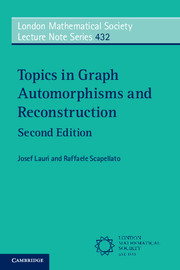Book contents
- Frontmatter
- Dedication
- Contents
- Preface to the Second Edition
- Preface to the First Edition
- 1 Graphs and Groups: Preliminaries
- 2 Various Types of Graph Symmetry
- 3 Cayley Graphs
- 4 Orbital Graphs and Strongly Regular Graphs
- 5 Graphical Regular Representations and Pseudosimilarity
- 6 Products of Graphs
- 7 Special Classes of Vertex-Transitive Graphs and Digraphs
- 8 The Reconstruction Conjectures
- 9 Reconstructing from Subdecks
- 10 Counting Arguments in Vertex-Reconstruction
- 11 Counting Arguments in Edge-Reconstruction
- References
- List of Notations
- Index of Terms and Definitions
6 - Products of Graphs
Published online by Cambridge University Press: 05 June 2016
- Frontmatter
- Dedication
- Contents
- Preface to the Second Edition
- Preface to the First Edition
- 1 Graphs and Groups: Preliminaries
- 2 Various Types of Graph Symmetry
- 3 Cayley Graphs
- 4 Orbital Graphs and Strongly Regular Graphs
- 5 Graphical Regular Representations and Pseudosimilarity
- 6 Products of Graphs
- 7 Special Classes of Vertex-Transitive Graphs and Digraphs
- 8 The Reconstruction Conjectures
- 9 Reconstructing from Subdecks
- 10 Counting Arguments in Vertex-Reconstruction
- 11 Counting Arguments in Edge-Reconstruction
- References
- List of Notations
- Index of Terms and Definitions
Summary
This chapter will deal with operations on graphs; these operations will be generically named ‘products’. The word is already in use for several known operations, like the direct product and the cartesian product. Our approach will try to be unifying; that is, we will offer a mathematical definition of what a ‘graph product’ is. All we require for such an operation is (1) to have the vertex-set as the cartesian product of the vertex-sets of the factors involved in the operation, and (2) to have adjacencies within the resulting product depending solely on the adjacencies inside the factors, according to certain given rules.
Our starting point will be the direct product (also often referred to in the literature as the categorical product), whose definition may be considered the simplest, and upon which we shall obtain all the other products as graph-theoretic unions of suitable direct products.
Most of the content of the present chapter is quite well known, but the results concerning the various graph products that we shall present will often have to be rephrased in order to be consistent with the scheme presented earlier.
We shall especially focus on how the connectedness of the product (as well as other matters, such as those concerning paths) is related to that of the factors. We shall also stress the properties of products as binary operations. Incidentally, let us recall that we consider finite graphs only. Accordingly, some refinements that make sense in the infinite case, such as the distinction between ‘weak’ and ‘strong’ products, will not be our concern. Also, the associative property shall be considered only from this finitary viewpoint.
Here is how this chapter is organised. The general definitions that are typical of our approach will be recalled in Section 6.1. The remaining sections will deal with properties of remarkable special cases, namely the direct product (Section 6.2); the cartesian, strong and lexicographic product (Section 6.3); the modular product; and the ‘Knight’ product (Section 6.4).
General products of graphs
We start with the definition of the direct product.
- Type
- Chapter
- Information
- Topics in Graph Automorphisms and Reconstruction , pp. 92 - 108Publisher: Cambridge University PressPrint publication year: 2016

